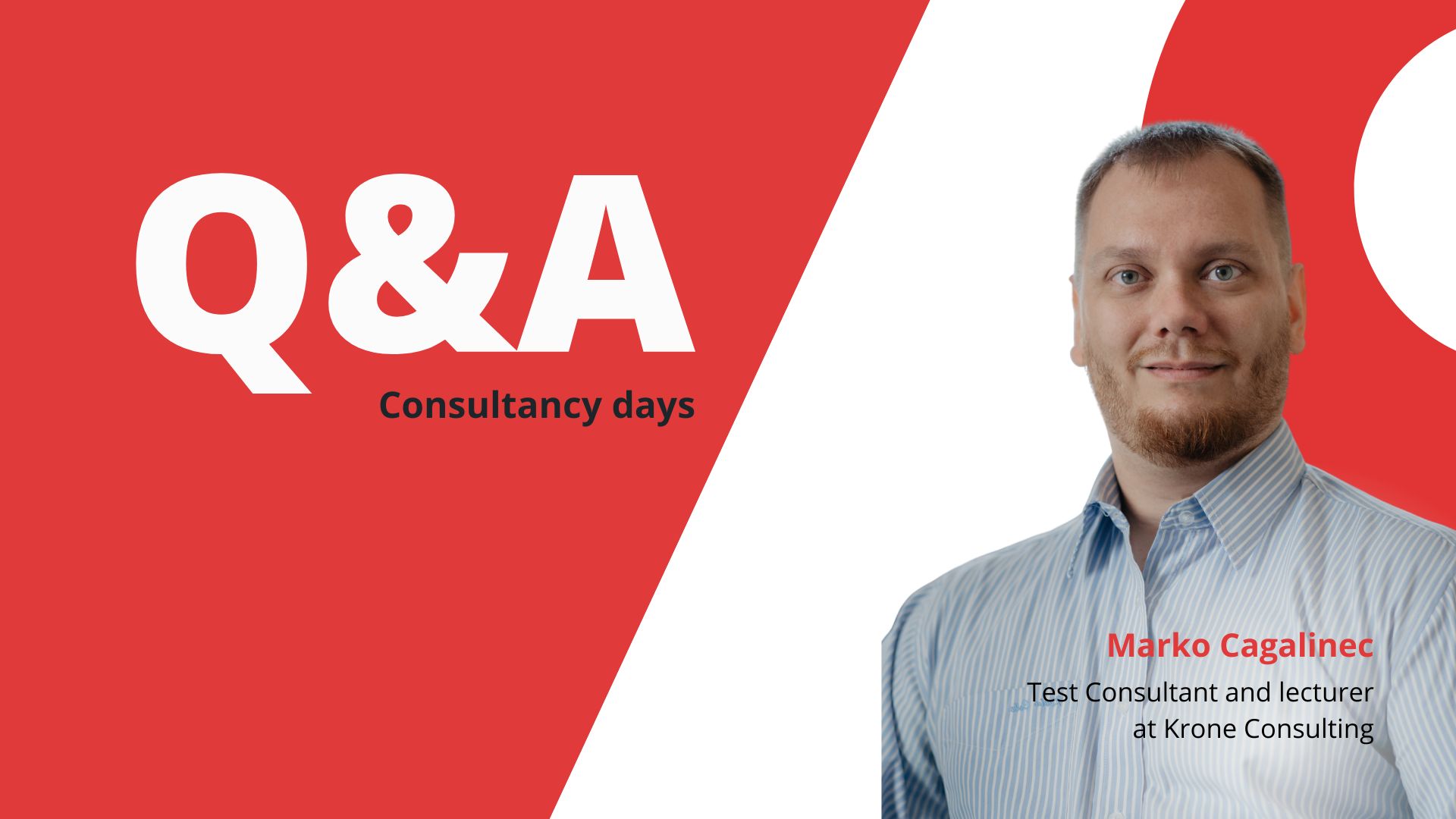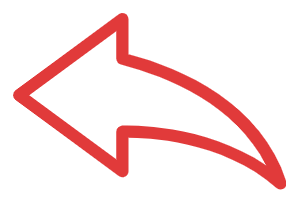Ask a Test Consultant. What questions did our staff ask Marko during the Consultancy Days?
Ask a Test Consultant. What questions did our staff ask Marko during the Consultancy Days?
Krone consultants and other partner consultants help our colleagues grow in their careers through Consultancy Days. During these days our people can discuss and ask about special topics in testing such as Test Architecture, Test Development, Scrum, Agile, Cypress, CI/CD and Management.
One of our first consultants was Marko Cagalinec, an expert in Scrum and Agile Consulting, and in this blog we have summarized the questions and answers that were mentioned.
Krone consultants and other partner consultants help our colleagues grow in their careers through Consultancy Days. During these days our people can discuss and ask about special topics in testing such as Test Architecture, Test Development, Scrum, Agile, Cypress, CI/CD and Management.
One of our first consultants was Marko Cagalinec, an expert in Scrum and Agile Consulting, and in this blog we have summarized the questions and answers that were mentioned.


What are the responsibilities of a Scrum Master?
Well, there are 2 answers, the first one is formally and officially correct and the second one is more of a reality how it often really looks like 😊. SM should officially be responsible only for ensuring that the agile team follows SCRUM, backs up and helps agile team members to identify methodologies and tools that fit them. In short, works like a support for the scrum team, but ideally the goal of a SM is to become obsolete because a well-established agile team does not need the SM on a permanent basis (they can occasionally come to advise, etc.).
Reality is often far from ideal lessons, so SM often takes not only couching, but also leadership role, where agile team turns to him with questions and SM suggests solutions, tools or ways to improve the operation. In the worst case, the SM starts to do some of the work of a project manager, but then it is a slow road back to waterfall (or watergile or agilefall as they sometimes like to call it).
What are the main problems and issues being addressed on projects in an agile environment?
I would say that these are almost the same issues that are being dealt with in the waterfall environment, the difference is rather in the way in which these issues and problems are being dealt with. The classic ones are: why are we late with the delivery, why didn’t everything we expected get delivered, why is the quality of the product low, “when will it be ready?”, why are the people in the team unhappy. Then there are additional questions when agility hits a waterfall elsewhere in the corporation: why do we have blockers, how can we remove them, “another team is deploying their delivery and has dependency on you.”
Of the more agile specific ones we don’t encounter that often: product owner is not satisfied with the team, product owner has no sense of control, scrum master micromanages, “the team just meets and doesn’t work at all.”
What is the future of Test Manager in an agile environment?
If we are talking about an ideal agile environment, this position or role does not exist. In reality, I see more potential for a shift to a testing consultant or better to say a coach who will teach the agile team how to increase the quality of QA and help them solve their specific problems until they move on.
Do you have experience when switching from an agile environment back to waterfall?
Personally, I don’t have this experience and have never experienced when it was officially done, realistically I’ve experienced when things gradually returned “to the old ways” and either directly in the agile team or someone was put in place who eventually did the role of PM and controlled and assigned tasks.
What about another modern trend in testing: Chapter Leads, what’s your opinion on it from a testing point of view?
In my opinion it is just a new trendy name for the classic matrix hierarchy of the company, but personally I think it is a good trend, because the idea of “full cross-functional” team members is rather useless and in today’s era of specialization basically unattainable. (Please note the difference between full cross-functional team and full cross-functional team member) For this reason it will be necessary for people who focus on QA, Dev or other to always have their “leads” who will show them how and where to develop further, what to improve personally or process-wise within the team, etc.
What do you think is necessary to be a Technical Test Consultant and what is not so necessary?
Personally,I don’t make a big difference between a technical test consultant and a technical consultant, it’s more about the background, but the expectations for both roles are the same for me, although the scope of their work differs.
A technical consultant is supposed to know the technologies on the market, not only what is trendy, but to know the variants, to be able to identify the advantages and disadvantages of the technologies and the difficulty of switching to these technologies. He must also be able to identify which people at the customer have the potential to learn which technologies, and then be able to propose to the customer the variants that should bring the expected/required results, the process and steps how to achieve them and determine or lead the necessary changes, whether technological, knowledge base or personal.
How to solve formal requirements for testing when moving to agile?
This is a very broad question and in the discussion we dealt with specific examples from reality, but in short it is about accepting that part of the delivery of an agile team is not only “sufficiently well-functioning software” but also any documentation required by the product owner (or by the respective regulators, ISO regulations, etc.). Of course, it is necessary that these requirements are also clearly described, defined and then taken into account in the sprints.
Blog author: Ivana Pristačová (HR&Marketing at Krone Consulting)
What are the responsibilities of a Scrum Master?
Well, there are 2 answers, the first one is formally and officially correct and the second one is more of a reality how it often really looks like 😊. SM should officially be responsible only for ensuring that the agile team follows SCRUM, backs up and helps agile team members to identify methodologies and tools that fit them. In short, works like a support for the scrum team, but ideally the goal of a SM is to become obsolete because a well-established agile team does not need the SM on a permanent basis (they can occasionally come to advise, etc.).
Reality is often far from ideal lessons, so SM often takes not only couching, but also leadership role, where agile team turns to him with questions and SM suggests solutions, tools or ways to improve the operation. In the worst case, the SM starts to do some of the work of a project manager, but then it is a slow road back to waterfall (or watergile or agilefall as they sometimes like to call it).
What are the main problems and issues being addressed on projects in an agile environment?
I would say that these are almost the same issues that are being dealt with in the waterfall environment, the difference is rather in the way in which these issues and problems are being dealt with. The classic ones are: why are we late with the delivery, why didn’t everything we expected get delivered, why is the quality of the product low, “when will it be ready?”, why are the people in the team unhappy. Then there are additional questions when agility hits a waterfall elsewhere in the corporation: why do we have blockers, how can we remove them, “another team is deploying their delivery and has dependency on you.”
Of the more agile specific ones we don’t encounter that often: product owner is not satisfied with the team, product owner has no sense of control, scrum master micromanages, “the team just meets and doesn’t work at all.”
What is the future of Test Manager in an agile environment?
If we are talking about an ideal agile environment, this position or role does not exist. In reality, I see more potential for a shift to a testing consultant or better to say a coach who will teach the agile team how to increase the quality of QA and help them solve their specific problems until they move on.
Do you have experience when switching from an agile environment back to waterfall?
Personally, I don’t have this experience and have never experienced when it was officially done, realistically I’ve experienced when things gradually returned “to the old ways” and either directly in the agile team or someone was put in place who eventually did the role of PM and controlled and assigned tasks.
What about another modern trend in testing: Chapter Leads, what’s your opinion on it from a testing point of view?
In my opinion it is just a new trendy name for the classic matrix hierarchy of the company, but personally I think it is a good trend, because the idea of “full cross-functional” team members is rather useless and in today’s era of specialization basically unattainable. (Please note the difference between full cross-functional team and full cross-functional team member) For this reason it will be necessary for people who focus on QA, Dev or other to always have their “leads” who will show them how and where to develop further, what to improve personally or process-wise within the team, etc.
What do you think is necessary to be a Technical Test Consultant and what is not so necessary?
Personally,I don’t make a big difference between a technical test consultant and a technical consultant, it’s more about the background, but the expectations for both roles are the same for me, although the scope of their work differs.
A technical consultant is supposed to know the technologies on the market, not only what is trendy, but to know the variants, to be able to identify the advantages and disadvantages of the technologies and the difficulty of switching to these technologies. He must also be able to identify which people at the customer have the potential to learn which technologies, and then be able to propose to the customer the variants that should bring the expected/required results, the process and steps how to achieve them and determine or lead the necessary changes, whether technological, knowledge base or personal.
How to solve formal requirements for testing when moving to agile?
This is a very broad question and in the discussion we dealt with specific examples from reality, but in short it is about accepting that part of the delivery of an agile team is not only “sufficiently well-functioning software” but also any documentation required by the product owner (or by the respective regulators, ISO regulations, etc.). Of course, it is necessary that these requirements are also clearly described, defined and then taken into account in the sprints.
Blog author: Ivana Pristačová (HR&Marketing at Krone Consulting)

